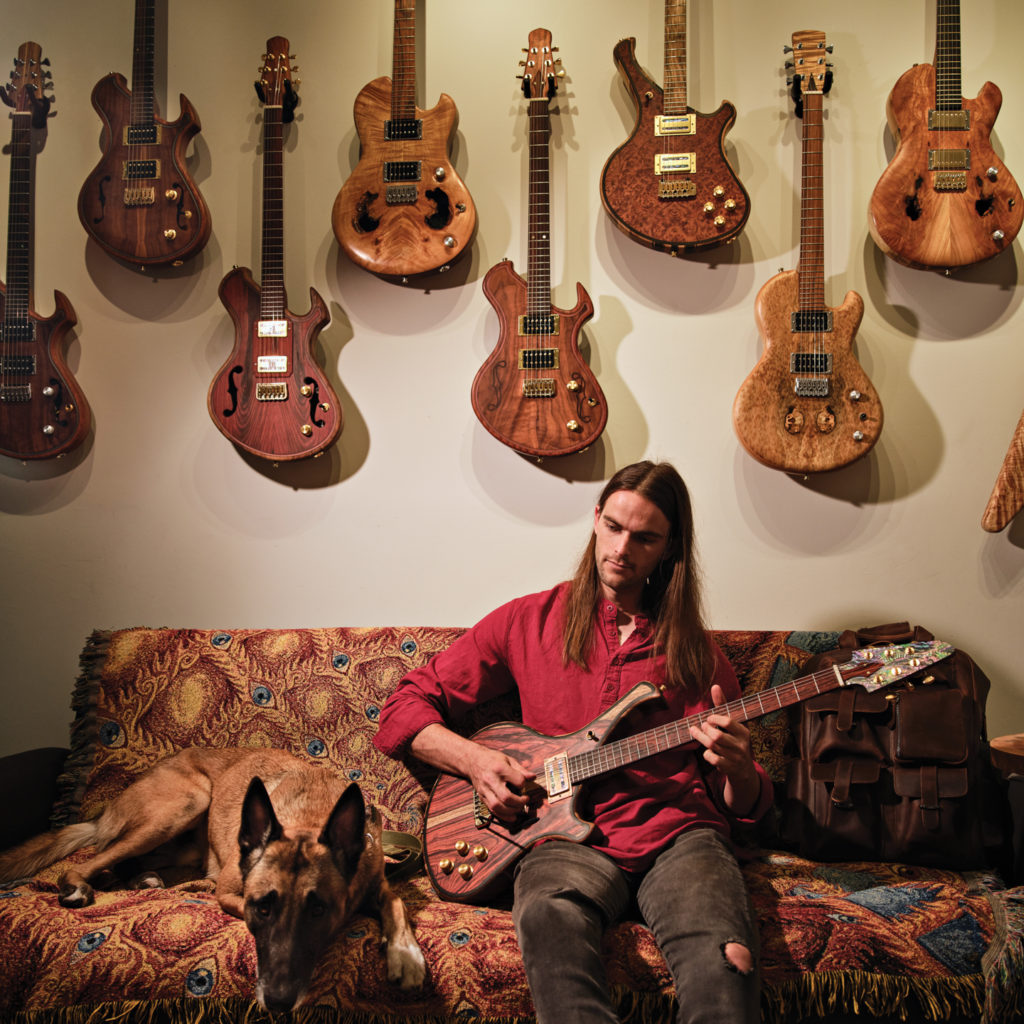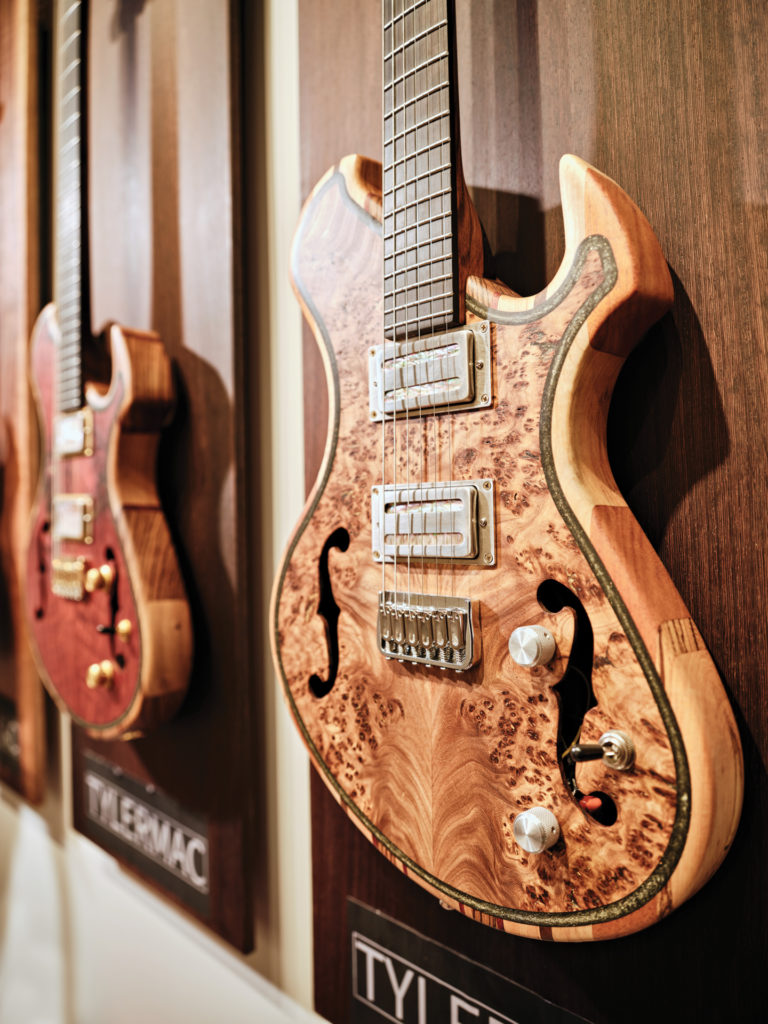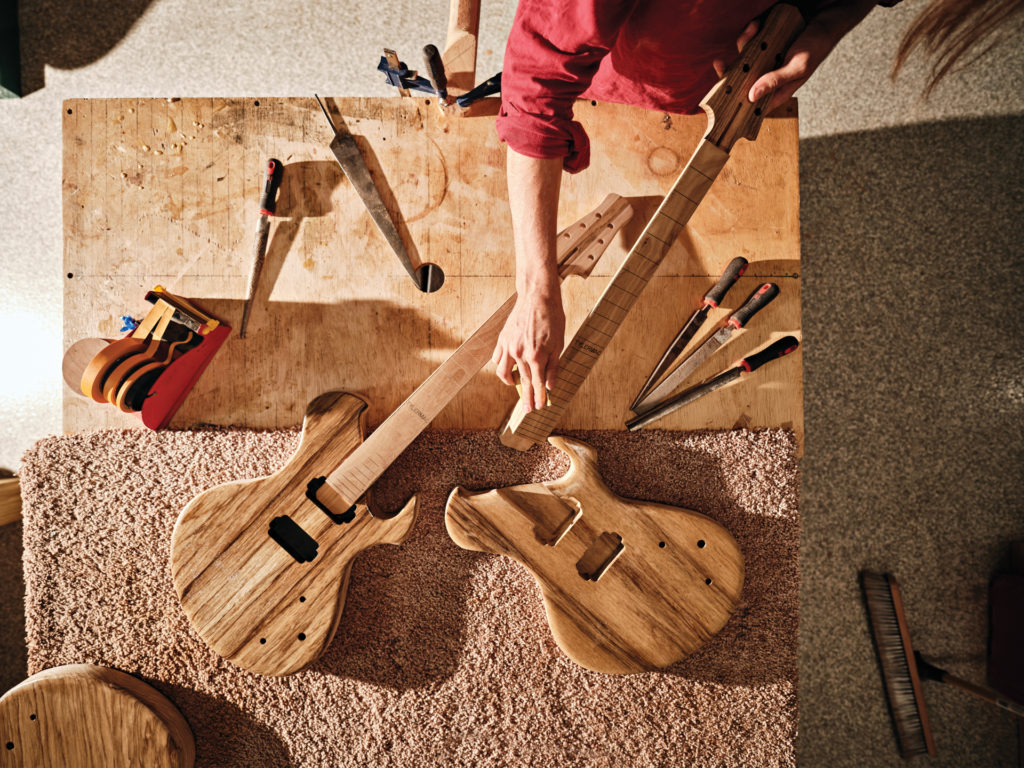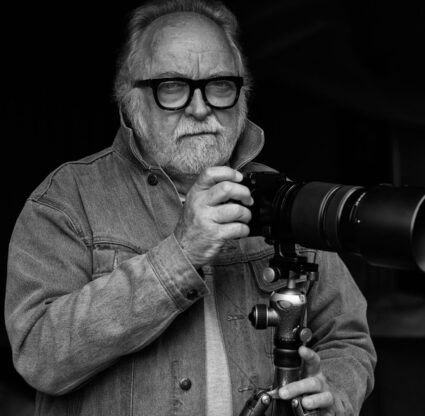Upon entering Tyler MacDonald’s studio in the Naples Art District, you’re struck by the rich wood tones and opalescent inlays of the guitars in his showroom. Sometimes, Tyler will be playing a few riffs that dance and mingle with the earthy scent that permeates the space. The 27-year-old Marco Island native is a luthier, a craftsperson who builds and repairs string instruments, such as violins and guitars. The design and fabrication of his handmade electric guitars begin with sourcing and shaping rare pieces of wood. While Tyler cuts the mahogany he uses locally, he imports other rough-cut lumber from all over the world, each piece carefully chosen for its durability, beauty and acoustics. “That’s a purpleheart from South America,” he says, pointing to a thick, pomegranate-colored slab, set amid neatly stacked rows that include pale moon ebony from Southeast Asia and padauk from Central and West Africa. His other hand reflectively scratches Slayer, his Belgian Malinois and studio cohort.
The process of handcrafting an electric guitar is split into two parts: The first is the construction of the guitar’s body, neck and head. For this, he uses power tools to saw, plane, drill and laminate the wooden pieces together, notching and beveling to allot space for the electrical components, which he’ll insert later. The second part involves sanding and refining the assembled guitar body, work so precise that only hand tools, like the old-fashioned wood chisels that hang on the wall can provide the control needed.
Tyler began his craft in 2019 when he wanted to learn how to play the guitar. “Building it first was a great way to understand the instrument,” he says. “It was easier to play, because I understood it.” In turn, being a musician allows him an intimate knowledge of his clients’ needs.
“The neck is the most complex and intricate part,” Tyler says. He carves the neck using rasps and files, and runs a thin steel rod, called a truss rod, through its interior. The rod functions like an artery through the core of the neck and can be adjusted to counteract the strings’ pull on the instrument. For Tyler, the finicky, complicated insertion process is worth the effort for the rods’ stabilizing effects. He also adds carbon fiber bars to strengthen the instrument for what he calls “ultimate tuning stability,” meaning his guitars rarely go out of tune.

He picks up one of the first guitars he made back in 2020. “It still plays really well,” he says proudly. It’s the first edition of his Arachnid series—each line of guitars falls under a different moniker influenced by heavy metal music or the natural world, such as Destroyer or Lotus. In keeping with the name, the Arachnid guitar’s shape echoes the angular body of a spider. “Each guitar is a very personal thing,” he continues. “Each has a personality and plays differently, depending on their different woods or how the neck is sanded.” He chooses not to lacquer or polish his guitars heavily, instead opting for a matte finish to complete the look. “I like to leave the wood more raw, so that you can feel the guitar vibrating when you play it,” he explains. “Lacquer is a layer of plastic that constrains the instrument.”
Though building guitars and playing them is a newer venture, Tyler has been a musician and artist for most of his life. The Marco Island native spent his childhood drawing or playing with clay. He started learning the saxophone at age 10; by age 11, he picked up photography, attracted to the camera’s mechanics. Two years later, his photos were gaining enough traction that he began selling them at art fairs around the state. When he graduated high school a year early, in 2013, he found himself running a profitable photography career while beginning an associate’s degree in art at Florida SouthWestern State College. It all boils down to his appreciation for “sophisticated tools or instruments.”
But Tyler knew something was off balance in his life. Even with international travel opportunities, his photography career felt stagnant. “I needed music back in my life,” he says. “It all goes back to the saxophone. I was mastering the saxophone, and then my path changed because my photography took off. I missed music. I didn’t play for years.”
Tyler says his desire to become a luthier was “somewhat irrational.” There was no proverbial lightning bolt that struck; he just felt a growing attraction to the mechanical and creative process of building guitars in tandem with his increasing desire to play them. So, he changed tack and began teaching himself the craft. Logically enough, the skills he honed as a photographer—his ability to compose or arrange an image, familiarity with the relationships between color and shape, and exacting attention to detail—prove indispensable when sketching and designing his instruments.

He also photographs his guitars. And they are far from standard studio shots. He leans his guitars against trees, tucked between roots; sometimes, small fires are lit between each tree, or a guitar is framed by dramatic foliage. This connection between the wooden instruments and their elemental settings is intentional: he’s reinforcing the point that “they all came from nature.”
With only three years under his belt as a luthier, Tyler’s established himself with clients across the country and a waitlist to purchase his guitars. Now he wants to focus more on finding the balance between playing music and making instruments. “What really excites me as a musician is the experience of setting up an atmosphere, an experience, an immersion,” he says. And that comes through in every visit to his studio, where he’s constructed a small stage where his band sometimes performs. Maybe the desire to build guitars was more rational and organic than he admits.





